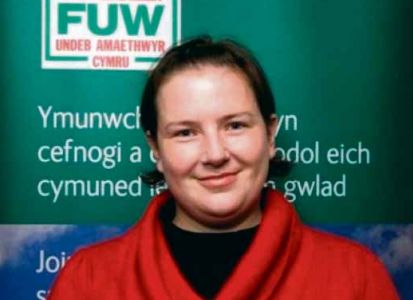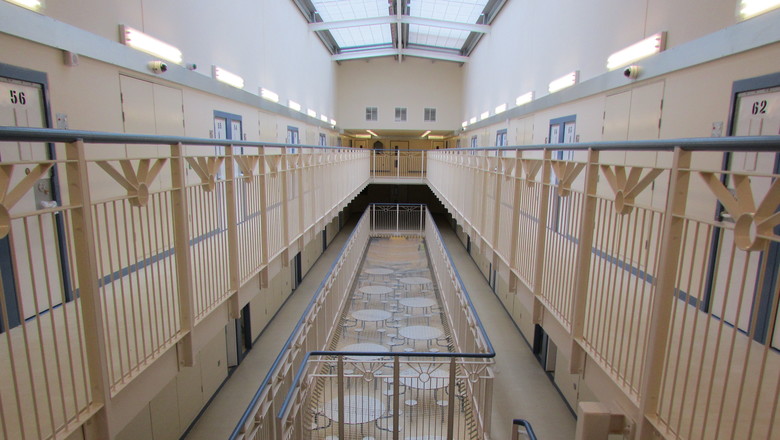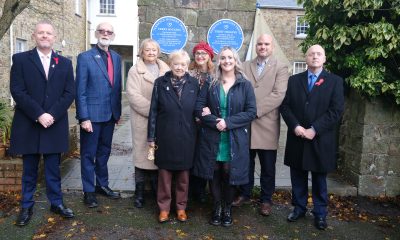News
No magic bullet for improving lamb production, FUW farm visit told

 IMPROVING the efficiency of lamb production was the main topic of discussion during a Farmers’ Union of Wales-organised visit to independent sheep consultant Catherine Nakielny’s Carmarthenshire family farm.
IMPROVING the efficiency of lamb production was the main topic of discussion during a Farmers’ Union of Wales-organised visit to independent sheep consultant Catherine Nakielny’s Carmarthenshire family farm.
Dr Nakielny, of KN Consulting, farms 800 ewes at her home at Talley, near Llandeilo. She previously worked for a commercial sheep breeding company and various industry consultants following her studies at Aberystwyth University where she completed an Animal Science BSc and PhD on Breeding Sheep for Resistance to Roundworms.
A Nuffield Scholar, she is chairman of the FUW’s animal health and welfare committee, the union’s Carmarthenshire county chairman, sits on the NSA Welsh committee and represents Wales on the NSA UK policy and technical committee.
She is also a Wales representative for the Moredun Research Institute, was a member of Farming Connect’s Agri Academy 2012 Rural Leadership Programme and received the National Sheep Association Cymru/Wales Award 2012.
She is a technical sheep specialist covering a variety of sheep production issues, has been involved in the sheep industry for over 15 years and has been working as an independent sheep consultant for the last five years.
Over this period she has been involved in a number of research and demonstration projects ranging from sheep breeding and genetic improvement to parasite control and winter forage costs.
In 2011 she was awarded a Nuffield scholarship and has since visited a number of countries including Ireland, New Zealand and Australia studying lamb production systems and new opportunities for improving flock profitability.
She studied the role of efficiency in reducing methane emissions from lamb production due to concerns that the climate change debate would lead to calls for a reduction in livestock numbers.
However, following a meeting with leading scientists and policy makers, it is clear that the need to produce more food to feed a growing population means that the focus will in the future lie with increasing efficiency of production and “sustainable intensification”.
Dr Nakielny has a particular interest in improving the efficiency of lamb production. She said:
“Whilst there is need to improve efficiency of production and much talk about sustainability, the future of lamb production lies in the ability of individual producers to create profitable businesses. Without this there is no sustainability.
“Policy makers and scientists have a role to play in supporting research and creating a framework in which producers can operate effectively but ultimately profitability results from taking control of an individual business and making the most of market opportunities and meeting the needs of consumers.
“Lamb is already a high value product on the shelves so we can’t expect to see rapid increases in what we receive for lamb so we need to think about the things we can control. There is no magic bullet and I believe that profitability will come from tackling a range of issues which currently reduce profitability.
“Risk management will also become increasingly important as well as being able to react to changing conditions based on a clear understanding of what drives the business.”
Dr Nakielny is therefore working with a number of producers to develop monitoring and benchmarking systems as well as working with Farming Connect to develop the Know Your Flock+ benchmarking groups.
Looking to promote innovation in the sector, Dr Nakielny has also developed The Ram Shop, a unique marketing tool for ram breeders as well as working on a number of tools to help with the monitoring and benchmarking of sheep flocks.
Crime
Swansea man dies weeks after release from troubled HMP Parc: Investigation launched

A SWANSEA man has died just weeks after being released from HMP Parc, the Bridgend prison now at the centre of a national crisis over inmate deaths and post-release failures.
Darren Thomas, aged 52, died on 13 November 2025 — less than a month after leaving custody. The Prisons and Probation Ombudsman (PPO) has confirmed an independent investigation into his death, which is currently listed as “in progress”.
Born on 9 April 1973, Mr Thomas had been under post-release supervision following a period at HMP/YOI Parc, the G4S-run prison that recorded seventeen deaths in custody in 2024 — the highest in the UK.
His last known legal appearance was at Swansea Crown Court in October 2024, where he stood trial accused of making a threatening phone call and two counts of criminal damage. During the hearing, reported by The Pembrokeshire Herald at the time, the court heard he made threats during a heated call on 5 October 2023.
Mr Thomas denied the allegations but was found guilty on all counts. He was sentenced to a custodial term, which led to his imprisonment at HMP Parc.
Parc: A prison in breakdown
HMP Parc has faced sustained criticism throughout 2024 and 2025. A damning unannounced inspection in January found:
- Severe self-harm incidents up 190%
- Violence against staff up 109%
- Synthetic drugs “easily accessible” across wings
- Overcrowding at 108% capacity
In the first three months of 2024 alone, ten men died at Parc — part of a wider cluster of twenty PPO-investigated deaths since 2022. Six occurred within three weeks, all linked to synthetic drug use.
Leaked staff messages in 2025 exposed a culture of indifference, including one officer writing: “Let’s push him to go tomorrow so we can drop him.”
Six G4S employees have been arrested since 2023 in connection with alleged assaults and misconduct.
The danger after release
Deaths shortly after release from custody are a growing national concern. Ministry of Justice data shows 620 people died while under community supervision in 2024–2025, with 62 deaths occurring within 14 days of release.
Short sentences — common at Parc — leave little time for effective rehabilitation or release planning. Homelessness, loss of drug tolerance and untreated mental-health conditions create a high-risk environment for those newly released.
The PPO investigates all such deaths to determine whether prisons or probation failed in their duties. Reports often take 6–12 months and can lead to recommendations.
A system at breaking point
The crisis at Parc reflects wider failures across UK prisons and probation. A July 2025 House of Lords report described the service as “not fit for purpose”. More than 500 people die in custody annually, with campaigners warning that private prisons such as Parc prioritise cost-cutting over care.
The PPO investigation into the death of Darren Thomas continues.
Crime
Woman stabbed partner in Haverfordwest before handing herself in

A WOMAN who stabbed her partner during a drug-fuelled episode walked straight into Haverfordwest Police Station and told officers what she had done, Swansea Crown Court has heard.
Amy Woolston, 22, of Dartmouth Street in Milford Haven, arrived at the station at around 8:00pm on June 13 and said: “I stabbed my ex-partner earlier… he’s alright and he let me walk off,” prosecutor Tom Scapens told the court.
The pair had taken acid together earlier in the day, and Woolston claimed she believed she could feel “stab marks in her back” before the incident.
Police find victim with four wounds
Officers went to the victim’s home to check on him. He was not there at first, but returned shortly afterwards. He appeared sober and told police: “Just a couple of things,” before pointing to injuries on his back.
He had three stab or puncture wounds to his back and another to his bicep.
The victim said that when he arrived home from the shop, Woolston was acting “a bit shifty”. After asking if she was alright, she grabbed something from the windowsill — described as either a knife or a shard of glass — and stabbed him.
He told officers he had “had worse from her before”, did not support a prosecution, and refused to go to hospital.
Defendant has long history of violence
Woolston pleaded guilty to unlawful wounding. The court heard she had amassed 20 previous convictions from 10 court appearances, including assaults, battery, and offences against emergency workers.
Defending, Dyfed Thomas said Woolston had longstanding mental health problems and had been off medication prescribed for paranoid schizophrenia at the time.
“She’s had a difficult upbringing,” he added, saying she was remorseful and now compliant with treatment.
Woolston was jailed for 12 months, but the court heard she has already served the equivalent time on remand and will be released imminently on a 12-month licence.
News
BBC apologises to Herald’s editor for inaccurate story

THE BBC has issued a formal apology and amended a six-year-old article written by BBC Wales Business Correspondent Huw Thomas after its Executive Complaints Unit ruled that the original headline and wording gave an “incorrect impression” that Herald editor Tom Sinclair was personally liable for tens of thousands of pounds in debt.

The 2019 report, originally headlined “Herald newspaper editor Tom Sinclair has £70,000 debts”, has now been changed.
The ECU found: “The wording of the article and its headline could have led readers to form the incorrect impression that the debt was Mr Sinclair’s personal responsibility… In that respect the article failed to meet the BBC’s standards of due accuracy.”
Mr Sinclair said: “I’m grateful to the ECU for the apology and for correcting the personal-liability impression that caused real harm for six years. However, the article still links the debts to ‘the group which publishes The Herald’ when in fact they related to printing companies that were dissolved two years before the Herald was founded in 2013. I have asked the BBC to add that final clarification so the record is completely accurate.”
A formal apology and correction of this kind from the BBC is extremely rare, especially for a story more than six years old.
-

 Crime2 days ago
Crime2 days agoDefendant denies using Sudocrem-covered finger to assault two-month-old baby
-

 Crime1 day ago
Crime1 day agoPembroke rape investigation dropped – one suspect now facing deportation
-

 Crime6 days ago
Crime6 days agoMan denies causing baby’s injuries as police interviews read to jury
-

 News1 day ago
News1 day agoBaby C trial: Mother breaks down in tears in the witness box
-

 Crime2 days ago
Crime2 days agoLifeboat crew member forced to stand down after being assaulted at Milford pub
-

 Crime3 days ago
Crime3 days agoDefendant denies causing injuries to two-month-old baby
-

 Crime3 days ago
Crime3 days agoPembrokeshire haven master admits endangering life after speedboat collision
-

 Crime16 hours ago
Crime16 hours agoMother admits “terrible idea” to let new partner change her baby’s nappies alone

















